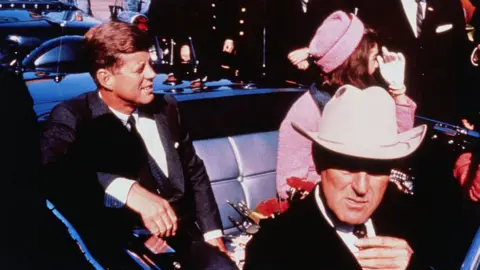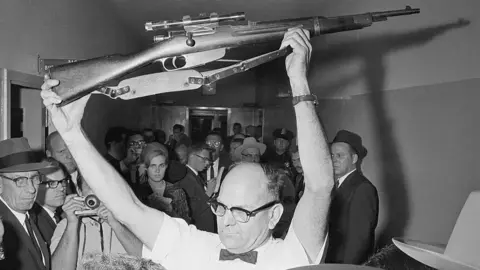Ex-Secret Service agent reveals new JFK assassination detail
 Getty Images
Getty ImagesSix decades later, new details are still coming to light in one of the most scrutinised events in American history: the assassination of President John F Kennedy.
Paul Landis, an 88-year-old former Secret Service agent who witnessed the president’s death at close range, says in new memoir that he took a bullet from the car after Mr Kennedy was shot, and then left it on the former president’s stretcher at the hospital.
It might seem like a minute detail in a case that has been pored over since the 1960s, and for which the government laid out an exhaustive report. But to individuals who have spent decades looking at every shred of evidence, Mr Landis’s account is a major and unexpected development.
Conspiracies over how many gunmen were involved, who was ultimately responsible, and how many bullets actually struck the president have abounded in the decades since the assassination.
The idea that the true facts of the case differ from the official version is modern America’s original conspiracy theory, and according to some historians, the killing instigated the nation’s decaying trust in its government.
Depending on how one looks at it, Mr Landis’s story either changes nothing or everything.
His book The Final Witness is guaranteed to add more kindling to the never-ending national obsession with the assassination.
“This is really the most significant news in the assassination since 1963,” said James Robenalt, a historian and Kennedy expert who worked with Mr Landis to prepare him for his public revelations.
New details in an old case
The primary facts of the Kennedy assassination are, by this point, well known and established.
On 22 November 1963, a convertible carrying President Kennedy, First Lady Jackie Kennedy, and Texas Governor John Connally Jr and his wife was driving through Dealey Plaza in Dallas when a series of shots rang out.
Mr Kennedy was struck in the head and neck, and Mr Connally was hit in the back. Authorities rushed both to nearby Parkland Memorial Hospital, where Mr Kennedy was declared dead. The governor survived.
 Getty Images
Getty ImagesThe Warren Commission report, the result of a government inquiry into the killing, identified Lee Harvey Oswald as the sole gunman. Ballistics evidence helped confirm this conclusion. He was shot and killed shortly after the assassination while in police custody.
The report also concluded that a single bullet travelled through Mr Kennedy and hit Mr Connally and caused several injuries, which helps explain how one gunman carried out the attack. The finding became known as the “single bullet theory” or “magic bullet theory”.
The commission partly relied on the fact that a bullet had later been found on Mr Connally’s hospital gurney.
At the time, nobody knew where it had come from. But the committee ultimately concluded that the bullet had become dislodged as doctors raced to treat Mr Connally.
Some sceptics of the official report have long fixated on the single bullet, finding it difficult to believe that it could have caused as many injuries as it did to two separate men.
Mr Landis’s account has landed like a bombshell not only because it provides a new first-hand testimony but because, in some views, it complicates the theory of the single bullet.
What Paul Landis remembers
On the day of the assassination, Mr Landis, then 28, was detailed to Jackie Kennedy.
When the violence began, he was just feet away from President Kennedy and witnessed the gruesome blow to his head.
Then came absolute pandemonium. What Mr Landis did next, he told no one but a few confidants for decades.
He picked it up and pocketed it. Shortly after, in his recollections, he was in an emergency room with President Kennedy, where he said he placed it on the president’s gurney so the evidence would travel with the body.
“There was nobody there to secure the scene, and that was a big, big bother to me,” Mr Landis told the Times.
“This was all going on so quickly. And I was just afraid that – it was a piece of evidence, that I realised right away,” he continued. “Very important. And I didn’t want it to disappear or get lost.”
Mr Landis apparently never came forward with this particular evidence, and while he filed reports and statements in the immediate aftermath, the Warren Commission never interviewed him. He never wrote it down in any official report.
“He was totally sleep deprived and was still required to work, and was suffering from severe PTSD,” Mr Robenalt told the BBC.
“He was totally absorbed in the enormous stuff that was going on.”
For years, he avoided reading about the assassination or the conspiracy theories it sparked – until he decided he was ready to tell his story to the world.
The mystery bullet
Those who have read Mr Landis’s account have taken different conclusions from it – and the story raises as many questions as it potentially answers.
Mr Robenalt told the BBC that he believes this account undermines the “single bullet” theory.
Mr Landis now believes the bullet he had found in the car was the one that turned up on Mr Connally’s gurney.
He believes the bullet had embedded shallowly in Mr Kennedy’s back and fallen out in the car.
If he is right, Mr Robenalt said, Mr Connelly and Mr Kennedy may not have been struck by the same bullet.
He even believes it could re-open scepticism about whether Mr Oswald acted alone.
If it had not been one bullet that caused both men’s injuries, Mr Robenalt asks in his extensive Vanity Fair piece, could Oswald have possibly fired both shots in such rapid succession with the rifle he used?
Mr Landis does have very serious sceptics, however, including a colleague who was also a direct participant that day.
Clint Hill, the agent who famously jumped onto the back of the Kennedy’s car to protect the president, does not believe Mr Landis’ account.
“If he checked all the evidence, statements, things that happened, they don’t line up,” Mr Hill told NBC News. “It doesn’t make any sense to me that he’s trying to put it on the president’s gurney.”
To Gerald Posner, an investigative journalist and author of Case Closed: Lee Harvey Oswald and the Assassination of JFK, Mr Landis’s story actually supports the “single bullet” theory.
“People would now know how the bullet wound up on Connally’s gurney,” he said.
Mr Posner said “his account has to be taken seriously”, but also had doubts about the certainty of Mr Landis’s memories after nearly six decades had passed.
For example, Mr Posner pointed toward interviews from people inside the emergency room with Mr Kennedy at Parkland hospital. No one mentions Mr Landis’s presence there, he said.
And the fact that Mr Landis never came forward raises questions about his conduct that day, Mr Posner said.
“That being said, he could say things that are wrong but the underlying fact that, ‘I saw a bullet, I grabbed it, put in my pocket, and left it at the hospital before I left’: that either is true or not,” Mr Posner said.
Whether or not Mr Landis opens a new mystery or simply confirms existing fact is almost beside the point.
This is the Kennedy assassination, after all, and his revelation will ensure continued years of debate and dissection of one of America’s greatest national traumas.
“Are you going solve it to anybody’s 100% satisfaction? No,” Mr Posner said. “It’s a case that will never be closed, for most people.”


